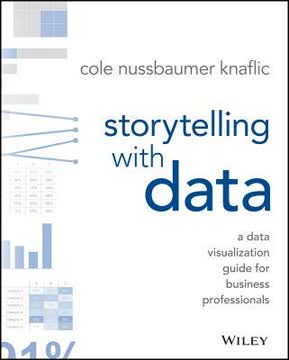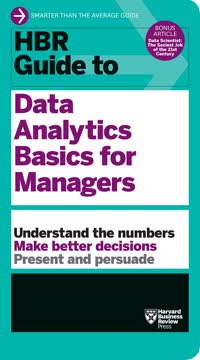Key Takeaways
1. Data literacy is essential for modern managers
"You don't need to become a data scientist or statistician to understand what the numbers mean."
Data-driven decision making. In today's business environment, managers must be able to work with data to make informed decisions. While you don't need deep statistical knowledge, understanding the basics of data analysis is crucial. This includes knowing how to frame questions, work with analysts, interpret results, and apply insights.
Key analytical concepts. Managers should familiarize themselves with fundamental concepts like regression analysis, statistical significance, correlation vs. causation, and predictive analytics. Having a grasp of these ideas will help you engage more effectively with data experts and ask the right questions about analyses.
Continuous learning. As data and analytics capabilities evolve rapidly, it's important for managers to stay current. Consider taking courses, attending workshops, or learning from internal experts to build your data literacy over time. The goal is to become a savvy consumer of analytics who can harness its power to drive better business outcomes.
2. Gather relevant data through targeted collection and experimentation
"Can you tell me something about the source of your data you used in your analysis?"
Identify key questions. Before collecting data, clearly define the business problem you're trying to solve and the specific questions you need to answer. This focused approach will help ensure you gather relevant information.
Data collection methods:
- Leverage existing internal data sources
- Conduct surveys or interviews
- Run controlled experiments (A/B testing)
- Access public datasets
- Partner with third-party data providers
Design effective experiments. When running tests to gather new data, follow scientific principles:
- Clearly state your hypothesis
- Randomize participants
- Use an appropriate sample size
- Control for confounding variables
- Measure outcomes objectively
By gathering high-quality, relevant data through thoughtful collection and experimentation, you lay the foundation for meaningful analysis and insights.
3. Choose meaningful metrics aligned with business objectives
"If these numbers go up, they might drive up sales of your product. But can you prove it?"
Avoid vanity metrics. Many companies track metrics that look impressive but don't actually drive business results. Focus instead on actionable metrics directly tied to your key objectives.
Align metrics to goals. Choose metrics that:
- Reflect your strategic priorities
- Drive desired behaviors
- Provide leading indicators of success
- Are specific, measurable, and time-bound
Regularly reassess. As your business evolves, continually evaluate whether your metrics still provide meaningful insights. Be willing to adjust or replace metrics that no longer serve your needs.
By selecting the right metrics, you ensure that your data analysis efforts focus on what truly matters for your organization's success.
4. Clean and validate data before analysis
"Can your data be trusted?"
Garbage in, garbage out. Even the most sophisticated analysis is worthless if based on flawed data. Invest time upfront to ensure your dataset is accurate and reliable.
Data cleaning steps:
- Remove duplicate entries
- Handle missing values appropriately
- Correct obvious errors
- Standardize formats and units
- Identify and address outliers
Validate data quality. Assess your data's completeness, consistency, and accuracy. Cross-reference against other sources when possible. Be transparent about any limitations or potential biases in your dataset.
Taking these steps to prepare your data will increase the validity of your analysis and the confidence you can place in your results.
5. Apply appropriate analytical techniques to extract insights
"Regression analysis in its various forms is the primary tool that organizations use for predictive analytics."
Choose the right tool. Different analytical techniques are suited for different types of questions and data. Common approaches include:
- Descriptive statistics
- Regression analysis
- Clustering and classification
- Time series analysis
- Machine learning algorithms
Consider complexity. Start with simpler techniques and progress to more advanced methods only if necessary. Often, basic analyses can provide valuable insights without the need for complex models.
Interpret results carefully. Understand the assumptions and limitations of your chosen technique. Be cautious about extrapolating beyond the bounds of your data or inferring causation from correlation.
By applying appropriate analytical methods, you can uncover meaningful patterns and relationships within your data to inform decision making.
6. Beware of cognitive biases when interpreting results
"Even with impressively large data sets, the best analytics tools, and careful statistical methods, managers can still be vulnerable to a range of pitfalls when using data to back up their toughest choices."
Common cognitive traps:
- Confirmation bias: Seeking data that supports pre-existing beliefs
- Overconfidence: Underestimating uncertainty in predictions
- Anchoring: Relying too heavily on one piece of information
- Availability bias: Overemphasizing easily remembered data points
Mitigate biases:
- Actively seek disconfirming evidence
- Consider alternative explanations for results
- Use structured decision-making frameworks
- Engage diverse perspectives in interpreting data
Embrace uncertainty. Recognize that data rarely provides absolute certainty. Be comfortable with probabilistic thinking and making decisions under conditions of ambiguity.
By being aware of these cognitive pitfalls and taking steps to counteract them, you can make more objective, data-informed decisions.
7. Communicate findings effectively through visualization and storytelling
"Data is worthless if you don't communicate it."
Visual impact. Well-designed charts, graphs, and infographics can make complex data more accessible and memorable. Choose visualizations that clearly highlight key patterns and relationships in your data.
Craft a narrative. Don't just present numbers—tell a compelling story with your data. Structure your communication around:
- The business context and question
- Key findings and insights
- Implications and recommended actions
Tailor to your audience. Consider your stakeholders' level of technical expertise and information needs. Adjust the depth and presentation of your analysis accordingly.
Effective communication of data insights is crucial for driving action and change within organizations. By combining clear visuals with a strong narrative, you can maximize the impact of your analytical work.
8. Cultivate data science talent to drive competitive advantage
"Data scientists realize that they face technical limitations, but they don't allow that to bog down their search for novel solutions."
Unique skill set. Data scientists combine statistical expertise, programming skills, business acumen, and communication abilities. This rare combination makes them valuable assets in extracting insights from complex data.
Organizational integration. To maximize the impact of data science:
- Align data science efforts with strategic priorities
- Foster collaboration between data scientists and domain experts
- Create a data-driven culture throughout the organization
Continuous innovation. Encourage data scientists to explore new techniques, tools, and data sources. Support experimentation and learning to stay at the forefront of analytical capabilities.
By investing in data science talent and creating an environment where they can thrive, organizations can gain a significant competitive edge in leveraging data for business value.
Last updated:
FAQ
What's "HBR Guide to Data Analytics Basics for Managers" about?
- Purpose: The book is designed to help managers understand and utilize data analytics to make informed business decisions.
- Audience: It targets managers who may not have a statistical background but need to work with data in their roles.
- Content: It covers the basics of data analytics, including gathering, analyzing, and communicating data insights.
- Structure: The book is divided into sections that guide readers through the data analytics process, from understanding data to making decisions based on it.
Why should I read "HBR Guide to Data Analytics Basics for Managers"?
- Skill Development: It helps managers develop essential data analytics skills, which are increasingly important in today's data-driven business environment.
- Decision Making: The guide provides tools and techniques to improve decision-making processes using data.
- Practical Advice: It offers practical advice and real-world examples to help managers apply data analytics in their daily work.
- Confidence Building: By demystifying data analytics, the book aims to build managers' confidence in using data to support their decisions.
What are the key takeaways of "HBR Guide to Data Analytics Basics for Managers"?
- Data Literacy: Managers need to understand where data comes from and how it can be used effectively.
- Analytical Process: The book outlines a three-step process: gathering data, analyzing it, and communicating findings.
- Avoiding Pitfalls: It highlights common mistakes in data analysis and how to avoid them.
- Collaboration: Emphasizes the importance of working effectively with data scientists and other experts.
What are the best quotes from "HBR Guide to Data Analytics Basics for Managers" and what do they mean?
- "Data is coming into companies at remarkable speed and volume." This highlights the growing importance of data in business and the need for managers to harness it effectively.
- "Never make the mistake of assuming that the results will ‘speak for themselves.’" This emphasizes the importance of communicating data insights clearly to drive action.
- "The goal is not to fi gure out what is going on in the data but to fi gure out what is going on in the world." This quote underscores the need to connect data analysis to real-world business contexts.
How does "HBR Guide to Data Analytics Basics for Managers" suggest managers gather the right data?
- Focused Questions: Start by asking the right questions to guide data collection efforts.
- Data Sources: Identify both internal and external data sources that can provide relevant information.
- Data Quality: Assess the quality of data to ensure it is reliable and trustworthy.
- Collaboration: Work with data scientists to determine the best methods for collecting and analyzing data.
What does "HBR Guide to Data Analytics Basics for Managers" say about analyzing data?
- Regression Analysis: The book explains regression analysis as a key tool for understanding relationships between variables.
- Predictive Analytics: It discusses how predictive analytics can forecast future trends based on past data.
- Avoiding Overfi tting: Warns against overfi tting models to data, which can lead to inaccurate predictions.
- Understanding Assumptions: Emphasizes the importance of understanding the assumptions behind data models.
How does "HBR Guide to Data Analytics Basics for Managers" recommend communicating data findings?
- Clear Storytelling: Use storytelling techniques to make data insights compelling and understandable.
- Visualizations: Employ effective data visualizations to highlight key points and trends.
- Audience Consideration: Tailor communication to the audience's level of understanding and interest.
- Actionable Insights: Focus on presenting data in a way that leads to actionable business decisions.
What common mistakes in data analysis does "HBR Guide to Data Analytics Basics for Managers" highlight?
- Confirmation Bias: Avoid focusing only on data that supports preconceived notions.
- Overconfidence: Be wary of overestimating the accuracy of data-driven insights.
- Ignoring Outliers: Pay attention to outliers, as they can provide valuable insights or indicate errors.
- Complex Models: Simplify models to avoid overfitting and ensure they are understandable and actionable.
How does "HBR Guide to Data Analytics Basics for Managers" define the role of a data scientist?
- Hybrid Role: Data scientists are described as a mix of data hacker, analyst, communicator, and trusted adviser.
- Curiosity: They possess an intense curiosity to explore data and uncover insights.
- Communication Skills: Effective data scientists can communicate complex data insights in a clear and compelling way.
- Business Impact: They focus on using data to drive business decisions and innovations.
What does "HBR Guide to Data Analytics Basics for Managers" say about the importance of data visualization?
- Clarity: Visualizations should make complex data more understandable and accessible.
- Engagement: Good visualizations engage the audience and highlight key insights.
- Avoiding Clutter: Avoid unnecessary elements that can distract from the main message.
- Purpose-Driven: Visualizations should be designed with a clear purpose and audience in mind.
How does "HBR Guide to Data Analytics Basics for Managers" address the challenge of uncertainty in data?
- Understanding Uncertainty: It explains the importance of recognizing and communicating uncertainty in data analysis.
- Probability and Risk: Discusses how to convey the probability of different outcomes and associated risks.
- Visualizing Uncertainty: Offers strategies for visualizing uncertainty to help stakeholders understand potential variability in results.
- Decision-Making: Emphasizes the need to incorporate uncertainty into decision-making processes.
What advice does "HBR Guide to Data Analytics Basics for Managers" offer for making data-driven decisions?
- Data-Driven Culture: Foster a culture that values data-driven decision-making across the organization.
- Continuous Learning: Encourage ongoing learning and adaptation as new data and insights become available.
- Collaboration: Work closely with data scientists and other experts to leverage their skills and insights.
- Balanced Approach: Combine data insights with intuition and experience to make well-rounded decisions.
Review Summary
HBR Guide to Data Analytics Basics for Managers receives mixed reviews, with an average rating of 3.90 out of 5. Readers appreciate its comprehensive overview of data analytics concepts, practical examples, and insights for managers. Many find it useful for beginners and as a reference guide. However, some criticize its superficial coverage of topics and lack of cohesion between articles. The book is praised for its clarity, real-world applications, and emphasis on critical thinking in data-driven decision-making. Overall, it's considered a valuable resource for managers seeking to understand data analytics basics.
Similar Books










Download PDF
Download EPUB
.epub digital book format is ideal for reading ebooks on phones, tablets, and e-readers.














